The internet has come a long way since its inception. It has evolved from a basic platform for sharing information and connecting people to a dynamic ecosystem that influences every aspect of our lives. Two major milestones in this evolution are Web2 and Web3, each representing a significant shift in how we interact with the digital world. In this comprehensive article, we’ll delve deep into the key differences between Web2 and Web3 and discuss the profound upgrade that Web3 promises for the internet.
What is Web2?
Web2, often referred to as the “social web,” is the current phase of the internet that most of us are familiar with. It emerged in the early 2000s and transformed the internet into a highly interactive and collaborative space.
Web2 Concepts
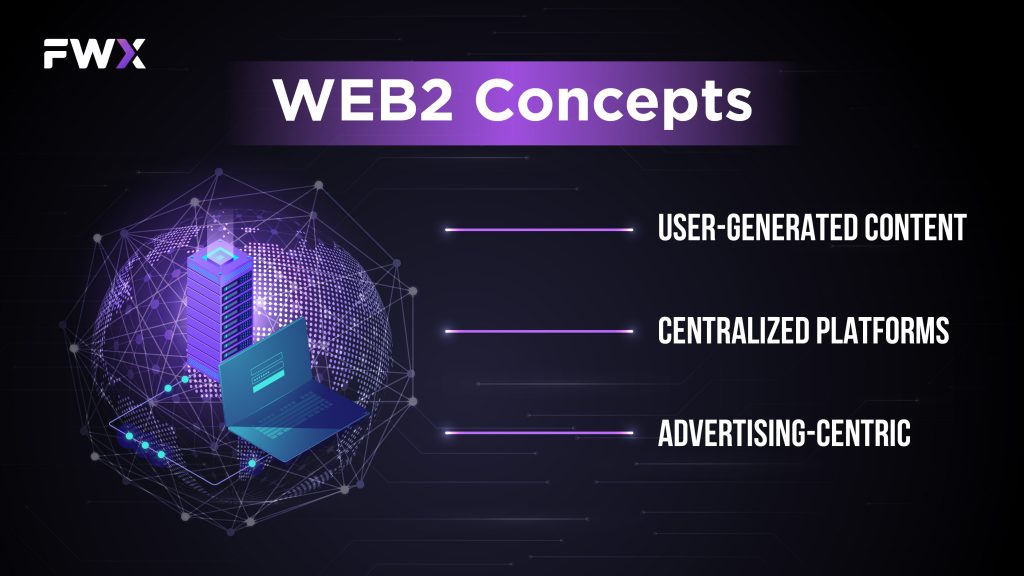
- User-Generated Content: Web2 relies on user-generated content, where individuals and organizations create and share information, media, and social connections. Platforms like Facebook, Twitter, and YouTube are quintessential examples.
- Centralized Platforms: Web2 platforms are centralized, meaning they are owned and controlled by a single entity. This centralization often leads to issues related to data privacy, censorship, and content manipulation.
- Advertising-Centric: The Web2 ecosystem is heavily reliant on advertising revenue, which can lead to issues of data exploitation and privacy violations.
Advantages and disadvantages of Web2
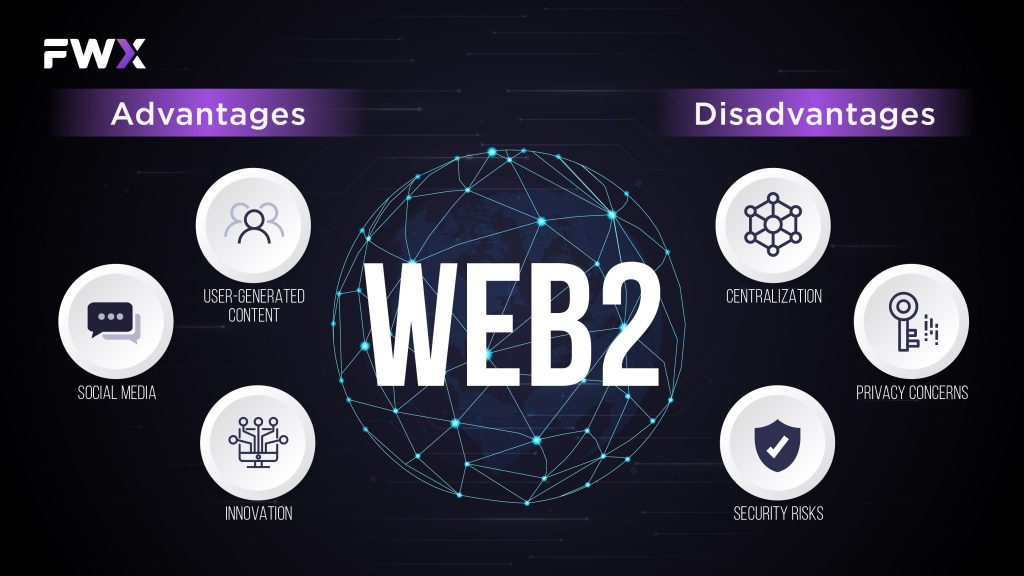
Advantages of Web2:
- User-generated content: Web2 allows users to create and share their own content, such as blog posts, videos, and social media posts. This has led to a more diverse and engaging internet experience.
- Social media: Web2 platforms have made it easier than ever for people to connect and interact with each other online. This has led to the rise of social media platforms, such as Facebook, Twitter, and Instagram.
- Innovation: Web2 has fostered a culture of innovation, with companies constantly developing new and innovative applications and services.
Disadvantages of Web2:
- Centralization: Web2 is dominated by centralized platforms, which control the flow of information and data. This can lead to censorship and a lack of transparency.
- Privacy concerns: Web2 platforms collect a lot of data about their users. This data is often used for targeted advertising, but it can also be misused or sold to third parties.
- Security risks: Web2 platforms are often the target of cyberattacks. This can lead to data breaches and other security vulnerabilities.
What is Web3?
Web3, often dubbed the “decentralized web,” is an emerging concept that aims to address the shortcomings of Web2. It envisions a more open, secure, and user-centric internet.
Web3 Concepts
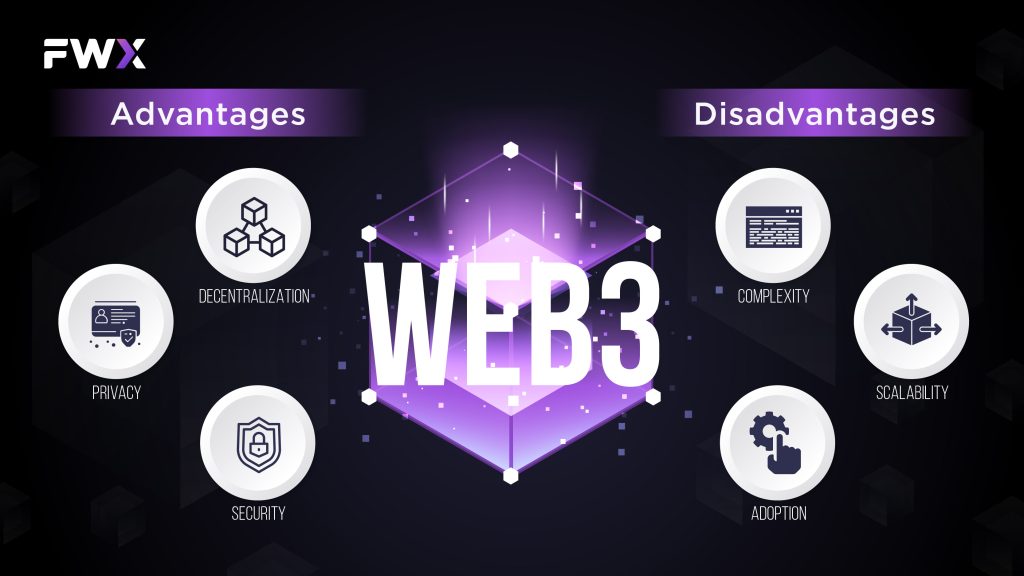
- Decentralization: Web3 is built on blockchain and distributed ledger technology, which allows for decentralized control and ownership of data. These shifts power away from centralized authorities and puts it in the hands of the users.
- Interoperability: Web3 focuses on enabling different platforms to communicate with one another through common protocols and standards, promoting a more seamless user experience. Users can have a unified online identity that spans multiple applications and services.
- Tokenization: Web3 introduces the concept of digital assets and tokens, which can represent anything from currency to digital collectibles. These tokens can be used to incentivize user participation and reward content creators.
Advantages and disadvantages of Web3
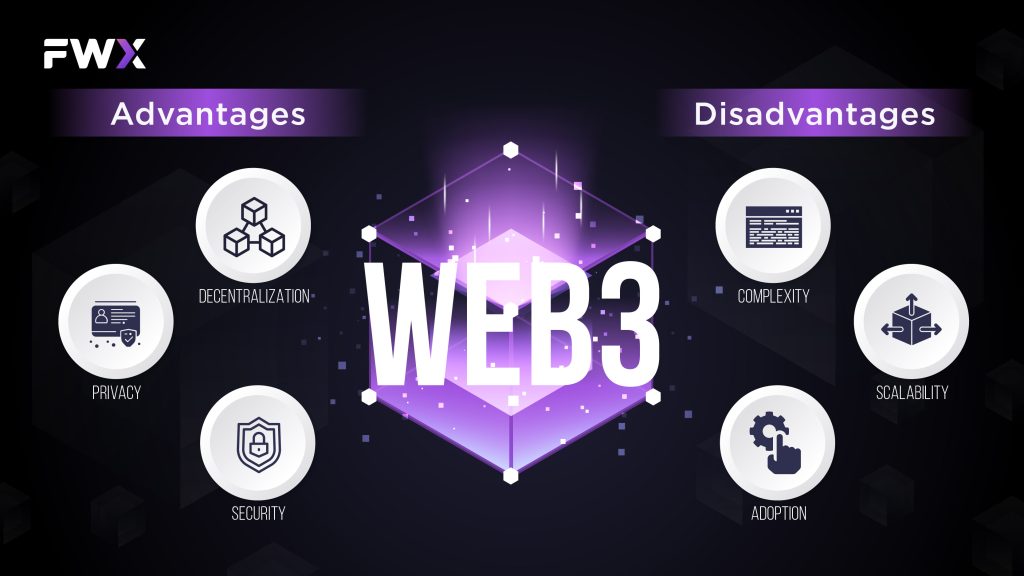
Advantages of Web3:
- Decentralization: Web3 is decentralized, meaning that it is not controlled by any single entity. This makes it more resistant to censorship and fraud.
- Privacy: Web3 applications give users more control over their data. Users can choose whether or not to share their data with applications and can also revoke access to their data at any time.
- Security: Web3 applications are more secure than Web2 applications because they are built on blockchain technology. Blockchains are distributed networks that are very difficult to hack or tamper with.
Disadvantages of Web3:
- Complexity: Web3 is a complex technology and can be difficult to understand and use.
- Scalability: Web3 applications are still in their early stages of development and can be slow and expensive to use.
- Adoption: Web3 is not yet widely adopted. This means that there are a limited number of Web3 applications available and it can be difficult to find users to interact with.
The Differences Between Web2 and Web3
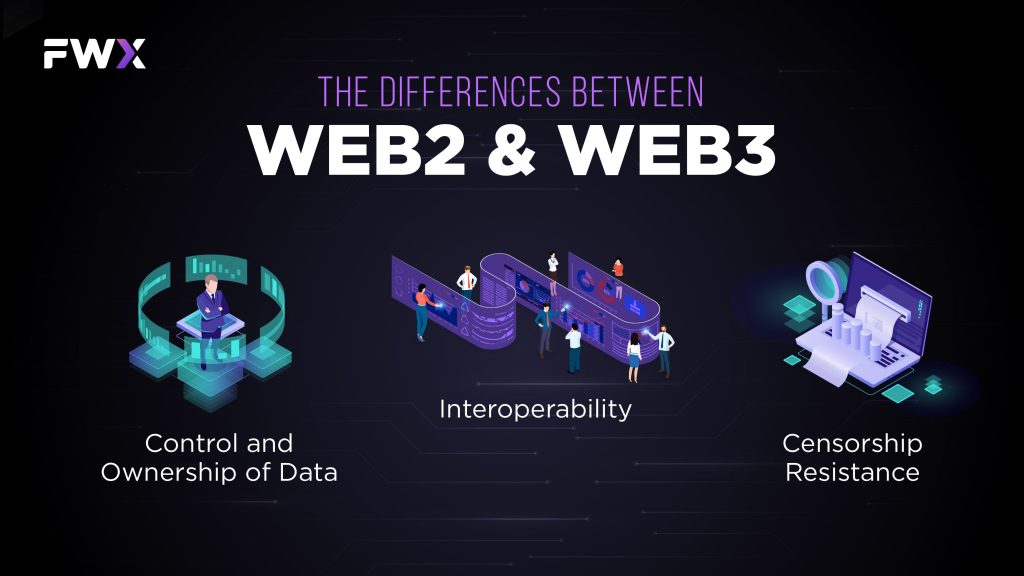
Web2 and Web3 represent two distinct eras in the evolution of the internet, each with its own set of characteristics that set them apart:
Control and Ownership of Data
Web2: In Web2, data control is centralized. Large corporations and platforms have access to user data, leading to concerns about data privacy, misuse, and surveillance. Users often have limited control over how their data is used.
Web3: Web3 focuses on decentralization. Users have greater control and ownership of their data, facilitated by blockchain and distributed ledger technology. This shift empowers individuals to decide how their data is shared and used.
Interoperability
Web2: Interoperability between different platforms and services can be limited. Users often need to create separate accounts for various applications, and data may be siloed.
Web3: Web3 promotes interoperability through common protocols and standards, enabling a more seamless user experience. Users can have a unified online identity that spans multiple applications and services.
Censorship Resistance
Web2: Web2 platforms have the authority to censor content, leading to concerns about freedom of expression and access to information.
Web3: Web3 is designed to be more censorship-resistant, as data and content are stored on decentralized networks. This can help protect free speech and prevent centralized authorities from controlling the flow of information.
Benefits of Web3 over Web2
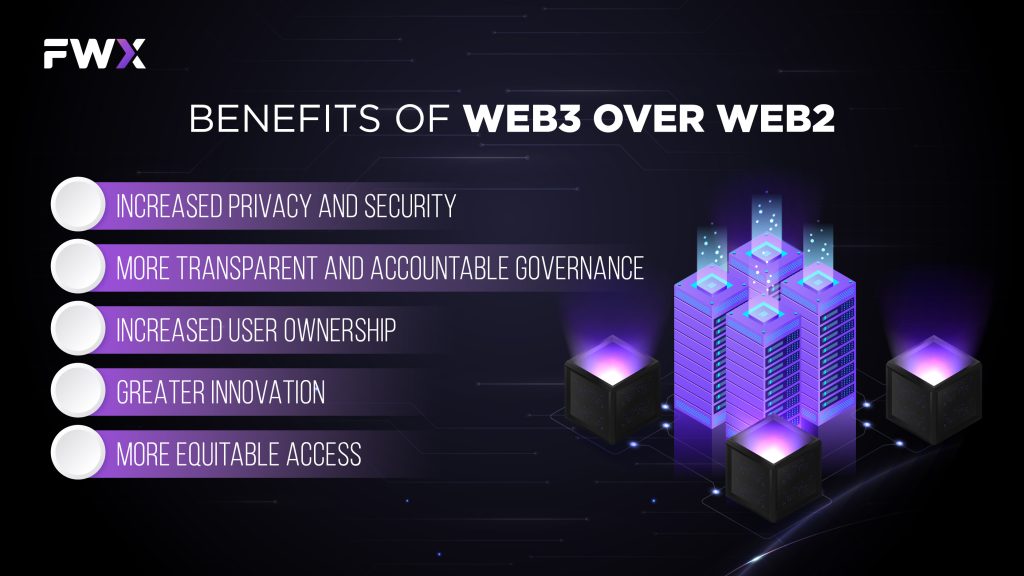
Web3 offers a number of benefits over Web2, including:
- Increased privacy and security: Web3 applications give users more control over their data and are more resistant to hacking and fraud. This is because Web3 applications are built on blockchain technology, which is a distributed ledger that is very difficult to tamper with.
- More transparent and accountable governance: Web3 applications are often governed by decentralized autonomous organizations (DAOs), which are more transparent and accountable than traditional corporate governance structures. DAOs are organizations that are run by their members, who vote on decisions and proposals.
- Increased user ownership: Web3 applications often give users the ability to own and govern the applications they use. This is because Web3 applications are often tokenized, meaning that users can own tokens that give them ownership and voting rights in the application.
- Greater innovation: Web3 is a new and rapidly developing field, which means that there are many opportunities for innovation. Developers are constantly building new and innovative Web3 applications and services.
- More equitable access: Web3 is designed to be more accessible than Web2. This is because Web3 applications are decentralized and do not require users to have a bank account or credit card.
The future of internet
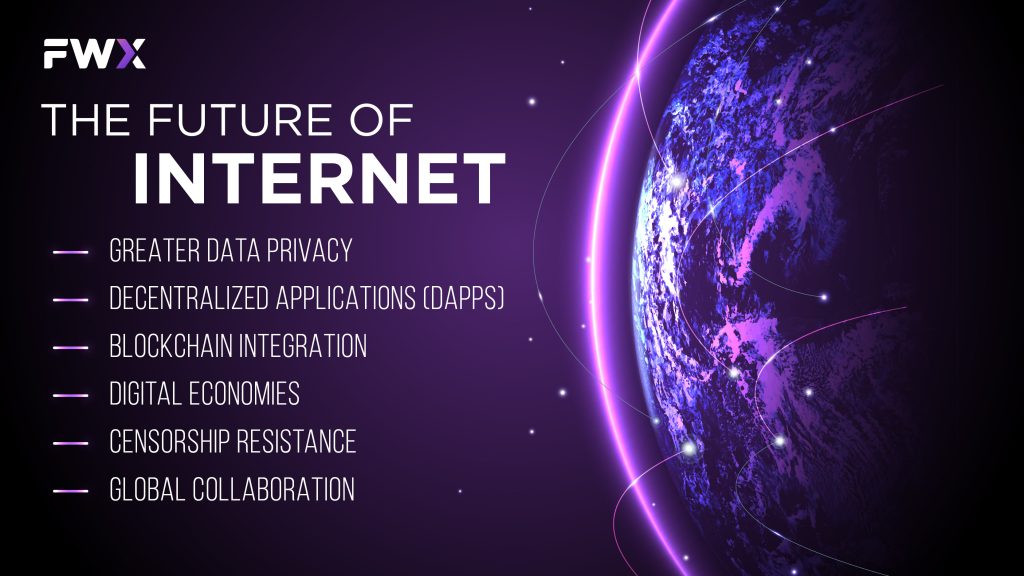
The future of the internet is likely to be shaped by Web3. Web3 offers a number of advantages over Web2, including increased privacy and security, more transparent and accountable governance, increased user ownership, greater innovation, and more equitable access.
Here are some specific examples of how Web3 could impact the future of the internet:
- Greater Data Privacy: Web3 will shift control over personal data back to users, providing them with enhanced privacy and data ownership.
- Decentralized Applications (DApps): The proliferation of DApps will offer a wide range of services that operate on decentralized platforms, giving users more choices and control.
- Blockchain Integration: The adoption of blockchain technology will expand beyond cryptocurrencies to various industries, ensuring greater transparency and security.
- Digital Economies: Web3 will introduce new economic models, enabling creators to earn directly from their content and participation in online communities.
- Censorship Resistance: Web3’s decentralized nature will make it more difficult for centralized authorities to censor information, protecting freedom of expression.
- Global Collaboration: Web3’s interoperability will foster global collaboration, allowing users to seamlessly interact across different platforms and services.
In conclusion, Web2 and Web3 represent different phases in the evolution of the internet. Web2 has brought about unprecedented connectivity but at the cost of data privacy and control. Web3, with its emphasis on decentralization and user ownership, offers a promising alternative. As Web3 continues to develop and gain traction, the future of the internet could be one where users are truly in charge of their online experiences, and where trust, security, and freedom are paramount. It’s a digital revolution that holds the promise of a more open, secure, and user-centric internet.


